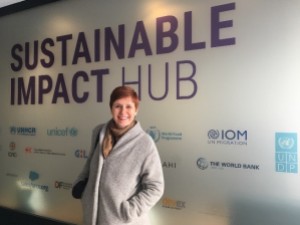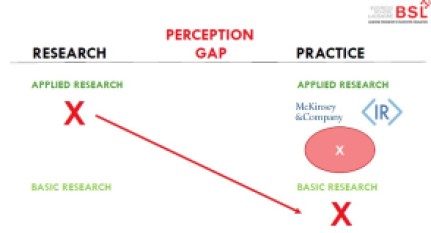Kommentar zur Publizierung des Green Business CEO Rating 2021 in der Bilanz vom 25.6.2021
Endlich ist es soweit, mit der Lancierung des Green Business CEO Ratings können wir erstmals die Unternehmensleistung der «inside-out» und «outside-in» Perspektive vergleichen (Dyllick & Muff, 2016). Die 50 grössten Schweizer Unternehmen wurden so erstmals auf die zwei Kerndimensionen der unternehmerischen Nachhaltigkeit geprüft. Nachhaltigkeitsmanagement wird bis heute noch weitgehend gleich gesetzt mit unternehmerischem Risikomanagement (oder: inside-out). Dabei geht es heute um sehr viel mehr: um positive Beiträge zur Lösung der grossen gesellschaftlichen Herausforderungen, die ohne Wirtschaft und Unternehmen nicht bewältigt werden können (oder: outside-in). Diese Herausforderungen können und sollen als neue Geschäftsfelder statt nur als Risiken erkannt und genutzt werden. Wir sind überzeugt, dass nur so Unternehmen einen relevanten gesellschaftlichen Impact in Bereichen wie Klimaschutz und Energieversorgung, Kreislaufwirtschaft, vernetzte Mobilität, nachhaltige Ernährung oder krisenresistente Gesundheitssysteme erzielen können.
Um dieses erweiterte Denken zu fördern misst das «Green Business CEO Rating» sowohl das Risikomanagement wie auch die positive Impact-Wirkung von Unternehmen:
- Inside-out: Nachhaltigkeitsmanagement als Risikomanagement fokussiert darauf, Kosten und Risiken für das Unternehmen zu reduzieren und die Wahrnehmung einer gesellschaftlichen Verantwortung zum Ausdruck zu bringen. Es dient primär der Absicherung des Unternehmens und basiert auf Erkenntnissen von der ESG-Ratings. Es dominiert eine Inside-Out-Perspektive, vom Unternehmen und seinen Auswirkungen auf die Gesellschaft. Die Ergebnisse bestehen zumeist aus Verminderungen der negativen Auswirkungen des Unternehmens (CO2-Belastungen, Ressourcenverbrauch, Abfälle, Emissionen).
- Outside-in: Hier geht es um positive Beiträge zur Lösung der gesellschaftlichen Nachhaltigkeitsherausforderungen. Diese bedingen eine Outside-In-Perspektive, einen Blick von der Gesellschaft auf das Unternehmen und von der Zukunft auf die Gegenwart. Diese Perspektive orientiert sich am Impact des Unternehmens auf die Gesellschaft wie sie sich in Gesetzgebungsverfahren wie dem Europäischen Green Deal oder am Kapitalmarkt im Zeichen des Impact Investings und einer expliziten Purpose-Orientierung von Unternehmen niederschlagen. Ihre Messung basiert auf Beiträgen zur Bewältigung der UN Sustainable Development Goals, der SDGs.
Das «Green Business CEO Rating» zeigt den positiven sozialen und ökologischen Impact der besten Grossunternehmen der Schweiz. Es bewertet erstmalig die Leistung von Unternehmen bezüglich eines positiven Beitrags zur Lösung der drängenden globalen Herausforderungen.
- Die Inside-out Perspektive wird einfachheitshalber mit der bekannten ESG-Bewertung (Environmental, Social & Governance) gleichgesetzt.
- Die Outside-in Perspektive wird kurz und prägnant als «Impact» bezeichnet.

DER BEITRAG DER UNTERNEHMEN ZUR LÖSUNG DER DRINGENSTEN PROBLEME UNSERER ZEIT
Die Nachhaltigkeitsperformance von Unternehmen kann in vier Quadranten gegliedert werden. Sie werden durch die beiden Achsen Risikomanagement (ESG) und “positive Wirkung auf Gesellschaft und Umwelt” (IMPACT) gebildet (siehe Abbildung 2). Auf einer 10er Skala liegt der gemessene Mittelwert aller Unternehmen bei 4.0. Dies zeigt auf, wie gross das Potential noch ist, um auf beiden Achsen besser zu werden.
Gruppe 1 – WIRKUNGSVOLL
Hier finden sich Unternehmen mit einem proaktiven Engagement bzgl. der Absicherung ihres Unternehmens vor Nachhaltigkeitsrisiken, welche sich gleichzeitig in Märkten befinden, die einen positiven Impact auf die SDGs haben. Hier befinden sich die Top-5 CEOs mit ihren Unternehmen, z.B. Swiss Re, Migros und Novartis. Diese Unternehmen sind in gesellschaftsrelevanten Märkten unterwegs, welche sie bereits früh dazu geführt haben, eine proaktive Haltung bezüglich gesellschaftlicher und ökologischer Probleme einzunehmen. Insbesondere ein Rückversicherer wie Swiss Re ist ein ausgezeichnetes Beispiel eines Unternehmens, das schon früh die hohen Kosten von Natur- und Klimaschäden – für die Gesellschaft und für sich selber – erkennen musste und daraus strategische Konsequenzen abgeleitet hat. Aber auch Unternehmen wie Migros oder Coop, sind in ihren Märkten direkt mit ökologischen und gesundheitlichen Problemen konfrontiert worden und haben die Erwartungen der Gesellschaft zu spüren bekommen. Sie haben schon früh eine wirkungsvolle Haltung eingenommen.
Gruppe 2 – EFFEKTIV
Hier finden sich Unternehmen, welche Produkte und Dienstleistungen in Märkten mit grosser Relevanz für Gesellschaft und Umwelt anbieten. Entweder weil sie seit jeher in diesen Märkten positioniert sind, oder aber ganz bewusst SDG-relevanten Dienstleistungen zur Lösung gesellschaftlicher Probleme entwickelt haben. Sie sind unauffällig, was ihr Risikomanagement betrifft, was auch an einer fehlenden Transparenz oder Berichterstattung liegen kann. Beispiele solcher Unternehmen sind Stadler Rail, Partners Group oder Baloise.
Gruppe 3 – AKTIV
Hier finden sich Unternehmen mit einem aktiven Engagement bzgl. Reduktion ihres negativen Impacts, welche Märkte bedienen, die nur einen geringen positiven Impact für Gesellschaft und Umwelt aufweisen. Unternehmen wie SGS, Holcim und Schindler sind aktiv und engagiert in ihrem Risikomanagement. Mit ihren Produkten und Dienstleistungen haben sie aktuell jedoch nur eine schwache Wirkung auf die Lösung von Nachhaltigkeitsherausforderungen im Sinne der SDGs.
Gruppe 4 – PASSIV
Hier finden sich Unternehmen mit nur geringem oder erst erwachendem Interesse an Nachhaltigkeit, welche in Märkten mit nur kleiner Relevanz für Gesellschaft und Umwelt aktiv sind. Ebenso wird ein Unternehmen hier aufgeführt, wenn es bezüglich seiner Nachhaltigkeitsperformance sehr intransparent kommuniziert. Beispiele solcher Unternehmen sind Swatch, Ems Chemie oder SFS Group. Unternehmen in dieser Gruppe weisen weder eine gute ESG-Bewertung, noch sind sie mit ihren Produkten und Dienstleistungen in SDG-Impact relevanten Märkten positioniert.

Die vier Kategorien in Abbildung 2 entstehen durch die beiden Unternehmensbewertungen – einerseits das ESG-Rating zur Absicherung des Unternehmens und andererseits das SDG-Impact-Rating bzgl. eines positiven Beitrags zu Gesellschaft und Umwelt. Die entsprechenden Positionierungen zeigen gut auf, wo Unternehmen stehen, sowohl bezüglich ihres Engagements für die Nachhaltigkeit als auch bezüglich des Impacts ihrer Produkte und Dienstleistungen. Die Unterschiede zwischen den beiden Ratingverfahren machen deutlich, dass es sich hierbei um ganz verschiedene Bewertungsperspektiven handelt (siehe Abbildung 1).
- ESG Rating für die traditionellen CSR Aktivitäten eines Unternehmens: Die ESG Best Practices Daten der Ratingagentur ISS fokussieren auf die klassischen ESG Kriterien (Umwelt, Soziales, verantwortungsvolle Unternehmensführung) und basieren auf einer Risikoperspektive der Nachhaltigkeit. Nachhaltigkeitsmanagement als Risikomanagement fokussiert darauf, Kosten und Risiken für das Unternehmen zu reduzieren und die Wahrnehmung einer gesellschaftlichen Verantwortung zum Ausdruck zu bringen (Inside-Out-Perspektive). Die Ergebnisse bestehen zumeist aus Verminderungen der negativen Auswirkungen des Unternehmens (CO2 Belastungen, Ressourcenverbrauch, Abfälle, Emissionen), aber nicht in positiven Beiträgen zur Lösung der gesellschaftlichen Nachhaltigkeitsherausforderungen.
- SDG-Impact Rating für die zukunftsorienterte «positive impact» Perspektive: Die SDG Analytics Daten der Ratingagentur Standard & Poor’s (S&P)/Trucost analysieren den positiven und negativen Impact jedes Unternehmens hinsichtlich aller 17 SDGs (Sustainable Development Goals der UN). Der Fokus liegt auf dem Blick von der Gesellschaft auf das Unternehmen und von der Zukunft auf die Gegenwart. Diese Outside-in-Perspektive orientiert sich am Impact des Unternehmens und der gesellschaftlichen Ausrichtung seiner Produkte und Dienstleistungen.
Es macht einen grossen Unterschied, ob die Absicherung des eigenen Unternehmens vor Nachhaltigkeitsrisiken mittels ESG-Daten bewertet wird oder der gesellschaftliche Impact des Unternehmens in Bezug auf die SDGs gemessen wird. Es gibt Unternehmen, die gut bzgl. ihrer ESG-Absicherung und solche die gut bzgl. ihres SDG-Impacts abschneiden. Es geht hierbei um die Ausrichtung der Nachhaltigkeitsaktivitäten, nicht um das Nachhaltigkeits-Engagement des Unternehmens. «Aktive» Unternehmen können sehr viel Aufwand betreiben, um ihr Unternehmen vor Nachhaltigkeitsrisiken zu schützen und Leistungen bzgl. der vielfältigen Messindikatoren nachzuweisen, ohne dass dies für den SDG-relevanten Impact viel bringt. Andererseits erreichen «effektive» Unternehmen aufgrund ihrer Produkt- und Marktausrichtung hohe SDG Impact-Werte, ohne dass dies zwingend eines besonderen Aufwandes bedarf.
Schlussendlich geht es aber nicht darum, die Leistungen in einem Bereich gegen den anderen auszuspielen. Beide Bereiche sind wichtig und wurden entsprechend für das Unternehmensrating auch gleich gewichtet.
Ihre Meinung interessiert uns. Wir freuen uns auf Ihre Kommentare!























 Author: Katrin Muff, PhD
Author: Katrin Muff, PhD